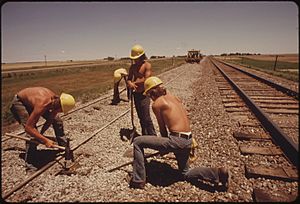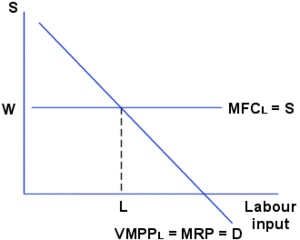Labour economics facts for kids
Labour economics, also called labor economics, is a field of study that looks at how people find jobs and how much they get paid. It explores the world of work, where people offer their skills and time, and companies hire them. Because people are part of a bigger social and political world, labour economics also considers how society, culture, and politics affect jobs.
The labour market is like a marketplace where workers and employers meet. Workers offer their services, and employers look for people to hire. Labour economics tries to understand why wages (pay), employment (how many people have jobs), and income (money earned) are the way they are. Everyone in this market is thought to make smart choices based on what they know about pay, their desire to work, and their desire for free time. While job markets are often local, the internet has created a global job market for some types of work.
Labour is the work done by people. It's different from other things needed for production, like land or money (capital). Some ideas focus on "human capital," which means the skills workers have. Labour is special because you can't separate the work from the person doing it. Also, in the labour market, workers are the ones selling their services, and companies are the ones buying them.
Contents
Big Picture of Job Markets (Macroeconomics)

When we look at the labour market from a big-picture view (macroeconomics), sometimes there are more people looking for jobs than there are jobs available. This can make wages grow slower than how much people are producing. If there are more workers than jobs, employers can choose from many people, which can keep salaries lower. But if there are more jobs than workers, salaries tend to go up because employers have to compete to find the people they need.
The labour force includes all people of working age who either have a job or are actively looking for one. The labour force participation rate is the percentage of the adult population that is part of the labour force. People not in the labour force include those not looking for work, like students, stay-at-home parents, or people in institutions.
The unemployment level is the number of people in the labour force who don't have a job. The unemployment rate is the percentage of the labour force that is unemployed. The employment rate is the percentage of the adult population that has a job. People who work for themselves are counted as employed.
An efficient labour market can help a country's economy grow faster. When labour is used efficiently, companies can produce more goods and services at a lower cost. This is often achieved through the "division of labour," where different people specialize in different tasks.
Things like the number of employed people, unemployed people, or job openings are called stock variables because they measure something at a specific moment. Flow variables measure changes over time, like how many people join the labour force or retire. Changes in unemployment happen when people start looking for jobs or lose them (inflows), or when they find jobs or stop looking (outflows).
Economists have identified different types of unemployment:
Natural Unemployment
- Frictional unemployment: This happens because it takes time for people to find new jobs that fit their skills. For example, using the internet to search for jobs has made this type of unemployment less common.
- Structural unemployment: This occurs when there aren't enough jobs in a certain industry for everyone who wants to work in it, or when people's skills don't match the available jobs. This can happen if industries change or if wages are too high, attracting too many workers.
- Natural rate of unemployment: This is the lowest unemployment rate an economy can usually achieve. It includes frictional and structural unemployment, which are always present. It doesn't include unemployment caused by economic downturns. Economists don't always agree on what this exact rate is, but it's usually between 1% and 5%.
Unnatural Unemployment
- Demand deficient unemployment (or cyclical unemployment): This happens during a recession when people and businesses don't spend enough money. This leads to less demand for goods and services, so companies need fewer workers.
- Seasonal unemployment: This type of unemployment is due to regular changes in demand for workers throughout the year. For example, retail jobs might decrease after the holiday season.
How Individuals and Companies Interact (Microeconomics)
In microeconomics, economists often see the labour market like any other market. The forces of supply (workers offering their time) and demand (companies needing workers) together decide the wage (price) and the number of people employed (quantity).
However, the labour market is different from other markets in some ways. For example, it might not always reach a perfect balance where everyone who wants a job has one. There can be ongoing unemployment. Also, similar workers might earn different amounts of money.
Worker's Choice: Work vs. Leisure
People are the suppliers of labour. They try to make choices that give them the most happiness. In the labour market, this means deciding how to balance free time (leisure) and working hours (to earn income). They are limited by the total hours in a day.
When wages go up, people can buy more goods and services. This can affect their decision to work more or less.
- Substitution effect: When wages rise, working becomes more rewarding compared to leisure. So, people might choose to work more hours to take advantage of the higher pay.
- Income effect: When wages rise, people earn more money for the same amount of work. They might decide they have enough money and choose to work fewer hours to enjoy more leisure time.
The final decision depends on which effect is stronger. Sometimes, people work more when wages rise, and sometimes they work less. This creates the labour supply curve, which shows how many hours people are willing to work at different wage rates.
Other things that affect how much people want to work include taxes, benefits, and the work environment.
Company's Need for Workers (Demand)
Companies demand labour because they need workers to produce goods or services. The demand for an additional worker depends on how much extra output that worker can produce and how much money that output will bring in. If a worker can bring in more money than they cost, the company will hire them. Companies will keep hiring workers until the cost of hiring one more worker is equal to the money that worker brings in.
The amount of equipment or technology a company has (called "capital") can affect how much a worker can produce. More capital often means a worker can produce more, which can lead to higher wages. Education and training are also seen as "human capital" that increases a worker's productivity.
As a company hires more and more workers, the extra output from each new worker usually starts to decrease. This is called the "law of diminishing returns."
Finding a Balance (Equilibrium)
The demand for workers from all companies can be added up to get the total demand for labour. Similarly, the willingness of all individual workers to work can be added up to get the total supply of labour. These total supply and demand curves help determine the average wage and employment levels in the economy.
Wages can be very different for different jobs. For example, a doctor earns much more than a cleaner, even if both work for the same organization. This is because a doctor's work brings in much more value, and it takes a lot more education and training to become a doctor. This means there are fewer doctors available, and the demand for them is high because medical care is essential.
When There's Only One Employer (Monopsony)
Some job markets have only one main employer. This is called a monopsony. In such a market, the employer has a lot of power. This can lead to fewer people being hired and lower wages compared to a market with many employers competing for workers.
When Information Isn't Perfect (Asymmetric Information)
In the real world, employers don't always know exactly how hard or productive their workers are. This can lead to a problem called moral hazard, where workers might not try their hardest because they know it's hard for the employer to tell. This can lower overall productivity.
One way to encourage workers to do their best is to give them things like stock options, which let them benefit when the company does well. Another way is to use flexible job contracts, where workers might adjust their hours based on what the company needs.
Another problem is when a company isn't sure about a worker's skills. If a company doesn't know a worker's true ability, they might pay a wage based on the average skill level of similar workers. This can mean highly skilled workers are paid less than they're worth, which might make them leave. This problem is called adverse selection.
To deal with adverse selection, companies might look for "signals" of ability. For example, they might assume that workers with more education are more skilled. However, education doesn't always mean someone is more productive.
Hiring and Incentives (Personnel Economics)
This area of economics looks at how companies manage their own workers. It studies how companies hire, keep, and let go of employees, and how they motivate them. This includes looking at different pay systems and how they encourage workers to be efficient.
Fairness and Differences (Discrimination and Inequality)
Inequality in the workplace usually refers to the unequal distribution of earnings among households. It's often measured using the Gini coefficient, which helps compare inequality between different places. Over time, inequality has generally been increasing. This is due to many reasons, like a higher demand for skilled workers compared to unskilled workers, and changes in technology that make skilled workers even more productive. Also, changes like less power for worker unions and a lower minimum wage can increase the gap between high and low earners.
Discrimination is when people are paid differently or treated unfairly because of things like their gender, race, or religion, even if these things don't affect how well they do their job. Many countries have laws to fight discrimination in the workplace. Economists use different ways to measure discrimination. For example, they might look at how much of a wage difference between groups is due to actual skill differences versus unfair treatment.
Some models suggest that employers might not hire minority workers if they believe it will cost them more, or if they think their customers might be prejudiced. This can lead to less hiring of certain groups.
Criticisms of Labour Economics
Some experts, especially sociologists, say that labour economics sometimes simplifies the complex reasons why people make job decisions. They argue that emotional factors and social benefits of a good income are important, not just the numbers.
However, many economists believe that their models are useful for understanding general human behavior in the job market, even if they don't capture every single personal detail. They use other ideas, like "information asymmetry" (when one side has more information than the other), to add more detail to their models.
Another point of criticism is that most labour market studies don't include unpaid labour, like unpaid internships or raising children. Even though this work isn't paid, it's very important for society. Recently, a field called "economics of the family" has started to study decisions made within households, including how families share work and raise children.
Wage Slavery
Some people criticize the modern labour market, using the term wage slavery to describe wage labour. They compare working for wages to slavery, suggesting that workers are forced to sell their labour to survive. This idea has been discussed for a long time, with some thinkers arguing that work done under external control doesn't truly come from a person's free choice.
Marxists, for example, believe that treating labour as a commodity (something to be bought and sold) is a major problem with capitalism. They argue that it reduces workers to a slave-like condition.
See also
 In Spanish: Economía laboral para niños
In Spanish: Economía laboral para niños
- Collective bargaining
- Employment
- Manual labour
- Human resources
- Economic rent
- Industrial relations





